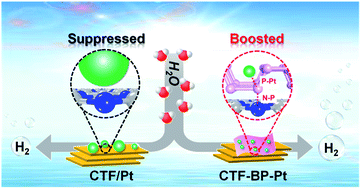Unveiling localized Pt–P–N bonding states constructed on covalent triazine-based frameworks for boosting photocatalytic hydrogen evolution†‡
Abstract
Developing highly efficient and stable photocatalysts for hydrogen (H2) evolution is a great challenge. Herein, a novel strategy using ultrathin black phosphorus (BP) as a bridge joint was proposed for controllable construction of a sandwich-type Pt-containing covalent triazine-based framework photocatalyst, CTF-BP-Pt. The as-prepared CTF-BP-Pt not only significantly enhances the stability of Pt nanoparticles but also dramatically improves the charge separation efficiency of the photocatalyst. For the first time, this work reveals that the unique Pt(δ+)–P(δ−)–N(δ+) surface bonding states in CTF-BP-Pt lead to a greatly improved H2 evolution rate (614.6 μmol g−1 h−1) compared with that of CTF directly doped with Pt (CTF/Pt, 167.5 μmol g−1 h−1). In addition, the Pt(δ+)–P(δ−)–N(δ+) configurations enabled the reduction of loading amount of Pt from the normal 2 wt% to 0.05 wt% but did not remarkably decrease the H2 evolution rate. It is noteworthy that the H2 evolution rate and its turnover frequency (TOF) obtained over the CTF-BP-Pt with 0.05 wt% Pt are much higher than those of other Pt loaded carbonaceous materials. Finally, the improvement of photocatalytic performance of CTF-BP-Pt was well explained based on many characterization experiments. The present work marks a critical step toward developing high-performance and low-cost photocatalytic H2 evolution materials.



 Please wait while we load your content...
Please wait while we load your content...